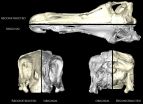(Press-News.org) Berlin, Germany (November, 2014) – Unexpectedly one of the largest diamond mines in Africa, Catoca in Angola, holds 118 million year old dinosaur, crocodile and large mammal tracks. The mammal tracks show a raccoon-sized animal, during a time when most were no larger than a rat.
Nearly 70 distinct tracks were recovered in the Catoca mine in Angola. All the tracks were found in a small sedimentary basin, formed about 118 Ma, during the Early Cretaceous, in the crater of a kimberlite pipe.
The most important of these finds are those whose morphology is attributable to a large mammalian trackmaker, the size of a modern raccoon. There is no evidence from bones or teeth of such a large Early Cretaceous mammal from Africa or elsewhere in the World. The most comparably sized mammalian skeleton is known from China, and is 4-7 Ma older than the Angolan tracks. It has an estimated head-body length between 42 and 68 cm, but because it is missing hands and feet, a comparison with the tracks from Catoca is not possible.
Nearby, 18 sauropod tracks were also found, with a preserved skin impression. These are the first dinosaur tracks found in Angola, and were discovered by the same paleontologist, Octávio Mateus, who found Angolatitan adamastor, the first Angolan dinosaur ever found, in 2005. Another trackway was attributed to a crocodilomorph trackmaker, a group that includes all modern crocodiles and extinct relatives, and has a unique laterally rotated handprint.
The tracks from Catoca represent the first fossils from the inlands of Angola ever found. The first mammal tracks were discovered in December, 2010 by the mine geologist Vladimir Pervov who contacted the paleontologist Octávio Mateus, who visited and collected the footprints in July 2011 and found the dinosaur tracks. For almost eight months, the Catoca Diamond Mine, fourth largest diamond mine in the World, stopped mining that sector, in order to preserve the findings and make the study possible. This work is part of the PaleoAngola Project, a scientific program of collaboration between various international institutions with the aim to research and promote vertebrate paleontology in Angola.
INFORMATION:
More information:
Marzola, M., Mateus, O., Schulp, A.S., Jacobs, L.L., Polcyn, M.J., Pervov, V. 2014. Early Cretaceous tracks of a large mammaliamorph, a crocodilomorph, and dinosaurs from an Angolan diamond mine. Society of Vertebrate Paleontology Annual Meeting, Program and Abstracts.
http://www.paleoangola.org
About the Society of Vertebrate Paleontology
Founded in 1940 by thirty-four paleontologists, the Society now has more than 2,300 members representing professionals, students, artists, preparators, and others interested in VP. It is organized exclusively for educational and scientific purposes, with the object of advancing the science of vertebrate paleontology.
Society of Vertebrate Paleontology website: http://www.vertpaleo.org
Journal of Vertebrate Paleontology
The Journal of Vertebrate Paleontology (JVP) is the leading journal of professional vertebrate paleontology and the flagship publication of the Society. It was founded in 1980 by Dr. Jiri Zidek and publishes contributions on all aspects of vertebrate paleontology.
Journal Web site: http://vertpaleo.org/Publications/Journal-of-Vertebrate-Paleontology.aspx
ABOUT THE AUTHORS
MARCO MARZOLA
is an Italian student studying in Portugal. During his academic studies, completed with a Master in Evolution, he mainly focused on dinosaur tracks from Northern Italy. Since November, 2012, he collaborates with the Museum of Lourinhã (Portugal). He worked as researcher for the international project DinoEggs, focused on the study of dinosaur and crocodile eggs from the Late Jurassic of Portugal and led by Prof. Octávio Mateus. Currently looking for a PhD, his main fields of interest are systematic and ichnology of Mesozoic archosaurs. marcomarzola83@gmail.com
OCTAVIO MATEUS
is professor of Paleontology at the Nova University of Lisbon, Portugal. He found the first dinosaur in Angola, in 2005, and the dinosaur tracks from Catoca, integrated in PaleoAngola Project. His main interests are Late Jurassic dinosaurs of Portugal, but he also focused different studies on other Mesozoic archosaurs, such as phytosaurs, mosasaurs, plesiosaurs, crocodiles, and turtles. His interest for paleontology and fossils has taken him to the United States, Brazil, Greenland, Laos, Tunisia, Mozambique, Mongolia, Morocco, South Africa, and Angola.
ANNE S. SCHULP
is a senior researcher in vertebrate paleontology at the national natural history museum Naturalis in Leiden, The Netherlands. Dr. Schulp's research mainly focuses on dinosaurs and mosasaurs, with a particular interest in paleoecology, the application of stable isotope analysis and dinosaur tracks. He is currently developing the new dinosaur gallery scheduled to open in 2017. He is one of the first members of the PaleoAngola Project research group.
LOUIS L. JACOBS
is professor of Earth Sciences at Southern Methodist University in Dallas, USA, and former president of the Society of Vertebrate Paleontology. His research concerns the interrelationships of biotic and abiotic events through time. His fieldwork is currently focused through Projecto PaleoAngola on the iconic, puzzle-like fit of Africa and South America, as viewed through the rocks and fossils of coastal Angola.
MICHAEL L. POLCYN
is a lecturer and researcher in the Huffington Dept. of Earth Sciences at Southern Methodist University, Dallas, Texas, USA. His current research interests include evolutionary patterns and processes in secondarily adapted marine amniotes with a particular focus on Mosasauroidea. He is also the founder and director of the Digital Earth Science Lab at SMU, a facility focused on applying imaging and other computer-based technologies to problems in paleontology. His fieldwork is currently focused in Upper Cretaceous marine deposits of Angola.
VLADIMIR PERVOV
is a Russian geologist who works for the Sociedade Mineira de Catoca, Angola. He is the discoverer of the first Catoca tracks and his collaboration was fundamental for their preservation and the survey. He also gave precious insights into the deposition of the sedimentary rocks in this unusual environment.
African diamond mine reveals dinosaur and large mammal tracks
2014-11-05
ELSE PRESS RELEASES FROM THIS DATE:
Jet-fueled electricity at room temperature
2014-11-05
SALT LAKE CITY, Nov. 5, 2014 – University of Utah engineers developed the first room-temperature fuel cell that uses enzymes to help jet fuel produce electricity without needing to ignite the fuel. These new fuel cells can be used to power portable electronics, off-grid power and sensors.
A study of the new cells appears online today in the American Chemical Society journal ACS Catalysis.
Fuel cells convert energy into electricity through a chemical reaction between a fuel and an oxygen-rich source such as air. If a continuous flow of fuel is provided, a fuel ...
Turning pretty penstemon flowers from blue to red
2014-11-05
While roses are red, and violets are blue, how exactly do flower colors change?
In the case of penstemons, with over 200 species to choose from, scientists Carolyn Wessinger and Mark Rausher have now shown that turning their flowers from blue to red involves knocking out the activity of just a single enzyme involved in the production of blue floral pigments.
A genetically conserved biochemical pathway produces the vivid blue pigments that they found to mutate over time to produce red. To shift into red pigment production, the enzyme flavonoid 3', 5' –hydroxylase ...
Patients with emergency-diagnosed lung cancer report barriers to seeing their GP
2014-11-05
MANY patients whose lung cancer is diagnosed as an emergency in hospital reported difficulties in previously seeing their GP, according to research presented at the National Cancer Research Institute (NCRI) Cancer Conference in Liverpool today (Tuesday).
The study, carried out by researchers from the London Cancer Alliance (LCA) and King's College London, investigated around 130 patients who were diagnosed with lung cancer after attending as an emergency at one of seven hospitals in south and west London.
Overall, nearly half of the patients reported that something ...
Scientists uncover potential drug to tackle 'undruggable' fault in third of cancers
2014-11-05
SCIENTISTS have found a possible way to halt one of the most common faults in many types of cancer, according to research presented at the National Cancer Research Institute (NCRI) Cancer Conference in Liverpool today (Wednesday).
A team of scientists at the Max Planck Institute of Molecular Physiology in Germany has
uncovered a new strategy and new potential drug to target an important signalling protein in cells called Ras, which is faulty in a third of cancers.
When the Ras protein travels from the centre of a cell to the cell membrane, it becomes 'switched on' ...
Trial results reveal first targeted treatment to boost survival for oesophageal cancer
2014-11-05
PATIENTS with a specific type of oesophageal cancer survived longer when they were given the latest lung cancer drug, according to trial results being presented at the National Cancer Research Institute (NCRI) Cancer Conference today (Wednesday).
Up to one in six patients with oesophageal cancer were found to have EGFR duplication in their tumour cells and taking the drug gefitinib, which targets this fault, boosted their survival by up to six months, and sometimes beyond.
This is the first treatment for advanced oesophageal cancer shown to improve survival in patients ...
Gene 'switches' could predict when breast cancers will spread to the brain
2014-11-05
SCIENTISTS have found a pattern of genetic 'switches' – chemical marks that turn genes on or off - that are linked to breast cancer's spread to the brain, according to research* presented at the National Cancer Research Institute Cancer Conference in Liverpool today (Wednesday).
The researchers, based at the University of Wolverhampton, studied 24 breast cancers that had spread to the brain, along with samples from the original breast tumour, and found a handful of genes with faulty switches.
Crucially, two of the genetic switches became faulty early on in the ...
New insight into the neuroscience of choking under pressure
2014-11-05
Everyone knows the scene: a basketball player at the free throw line, bouncing the ball as he concentrates on the basket. It's a tight game, and his team needs this point. He regularly makes baskets from much farther away while avoiding defenders, but now, when all is calm, he chokes and misses the basket, and his team loses. Recent research from The Johns Hopkins University suggests that in situations like this, performance depends on two factors: the framing of the incentive in terms of a loss or a gain, and a person's aversion to loss.
"We can measure someone's loss ...
Oxytocin levels in blood, cerebrospinal fluid are linked, Stanford study finds
2014-11-04
For years, scientists have debated how best to assess brain levels of oxytocin, a hormone implicated in social behaviors. Now, researchers at the Stanford University School of Medicine have found the first direct evidence in children that blood oxytocin measurements are tightly linked to levels of oxytocin in cerebrospinal fluid, which bathes the brain.
Low oxytocin levels in blood and CSF are both correlated to high anxiety levels, the research also showed. The findings will be published online Nov. 4 in Molecular Psychiatry.
"So many psychiatric disorders involve ...
Digital dinosaurs: New research employs high-end technology to restore dinosaur fossil
2014-11-04
Fossils are usually deformed or incompletely preserved when they are found, after sometimes millions of years of fossilization processes. Consequently, fossils have to be studied very carefully to avoid damage, and are sometimes they are difficult to access, as they might be located in remote museum collections. An international team of scientists, led by Dr. Stephan Lautenschlager from the University of Bristol now solved some of these problems by using modern computer technology, as described in a recent issue of the Journal of Vertebrate Paleontology.
The team consisting ...
Nonobstructive CAD associated with increased risk of heart attack, death
2014-11-04
In a study that included nearly 38,000 patients, those diagnosed with nonobstructive coronary artery disease (CAD) had a significantly increased risk of heart attack or death one year after diagnosis, according to a study in the November 5 issue of JAMA.
Nonobstructive coronary artery disease (CAD) is atherosclerotic plaque that would not be expected to obstruct blood flow or result in anginal symptoms (such as chest pain). Although such lesions are relatively common, occurring in 10 percent to 25 percent of patients undergoing coronary angiography, their presence has ...


